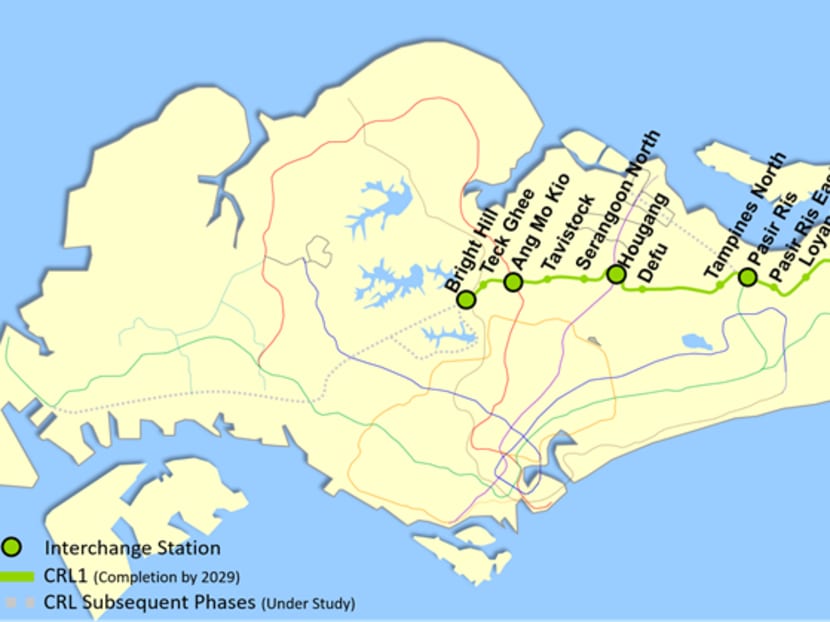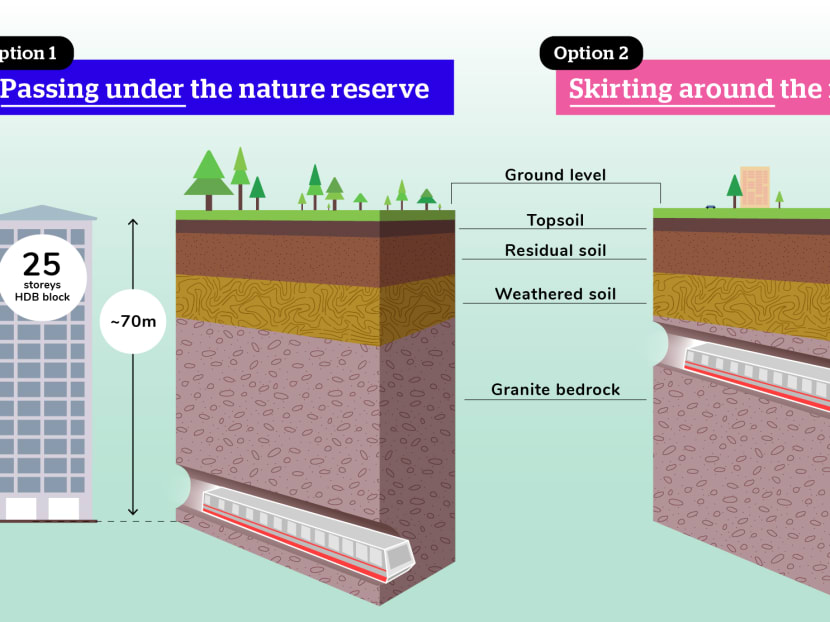Explainer: How 2 proposed tunnelling routes for Cross Island Line will affect wildlife, housing areas
SINGAPORE — The authorities are inviting public feedback on two proposed construction choices for the future Cross Island Line. This is after the second stage of a report assessing the environmental impact of building Singapore’s eighth MRT line was gazetted on Monday (Sept 2).

The Cross Island Line, which will have about 30 stops, will be built in stages. The first stage is expected to be opened in 2029 with 12 stations (above).
SINGAPORE — The authorities are inviting public feedback on two proposed construction choices for the future Cross Island Line.
This is after the second stage of a report assessing the environmental impact of building Singapore’s eighth MRT line was gazetted on Monday (Sept 2). Gazetting allows public inspection of the report and feedback on its findings.
The Cross Island Line — which is set to run from Changi to Jurong and is expected to be opened in 2029 with 12 stations first — can either run directly under the Central Catchment Nature Reserve or go around it. It would take a longer route and be more costly to build if it skirts around the reserve.
However, both are feasible options when done with comprehensive mitigating measures and monitoring plans, the latest environmental-impact assessment found.
How will it affect the nature reserve or residents living around the train line? Here is a rundown of the key points to note.
OPTION 1: CUTTING BENEATH THE NATURE RESERVE
This option of direct tunnelling will mean that 4km of the route will run beneath the Singapore Island Country Club’s Island Golf Course, Central Catchment Nature Reserve and Pan Island Expressway. Of this, 2km will be under the reserve.
The tunnel will be built about 70m below average ground level, or around the height of a 25-storey public housing block. This will be the deepest MRT tunnel in Singapore.
On average, underground MRT tunnels are built at less than half that depth, at about 30m.
With this option, trips from Bright Hill Station in Sin Ming to the next yet-unnamed stop in the second operational phase of the Cross Island Line will take about five minutes.
Two above-ground work sites will have to be built away from the nature reserve, along Island Club Road and to the west of the reserve.
What are some of the ecological effects from this option?
Loss of habitat: The report found that, before mitigating measures are taken, the impact on species at both worksites would be major owing to the loss of vegetation and habitat resources. This is because 1.5ha of forested land would have to be cleared, with 1.2ha to be replanted after construction.
Mitigating measures will include surveys to identify flora species that can be conserved or salvaged for relocation, and wildlife shepherding.
These will reduce the residual impact to “moderate”, meaning the effects are “around the existing conditions” or accepted standards, or both.
Breaking up habitats: Clearance and construction activities were also assessed to have a potentially major impact in breaking up habitats at the Island Club Road worksite and a moderate impact at the site to the west of the reserve.
Mitigating measures will include setting up artificial crossing aids such as poles and rope bridges designed for creatures that live among trees such as the Malayan colugo, a gliding mammal, and the Raffles’ banded langur, a monkey, to help lower the impact to moderate levels.
Threats from vehicular traffic: Wildlife facing the risk of increased injury or death from being struck by vehicles was also assessed to be major.
Enforcing speed limits along Island Club Road and designing hoardings that take into account the context of the site will reduce these effects to moderate.
In summary: Aside from the ecological impact, other effects include those that relate to the environment such as ambient noise and air quality. In all, with mitigating measures, the impact across all factors will be lowered to moderate or minor, from moderate to critical levels.
OPTION 2: SKIRTING AROUND THE NATURE RESERVE
This option to build tunnels skirting the reserve would create a 9km route. These would be built at around 45m below average ground level.
A government estimate in 2016 showed that it would cost about S$2 billion more to go with this choice.
With this option, commuters will take a longer travelling time of 11 minutes from Bright Hill to the next station in the second operational phase of the Cross Island Line.
Three above-ground worksites will have to be built. The first worksite will be near Lakeview estate and the other two are along Lornie Road as well as between Adam Drive and the Pan Island Expressway.
An international panel of advisers on tunnelling and underground construction cautioned that the risk of incidents — tunnelling works could cause damage and cracks to buildings, for example — is higher for this option than for the first option, because of the “concentration of facilities including infrastructure and occupied buildings”.
With measures in place though, the panel said that the tunnels can be built to an “acceptable level of risk” — meaning there will be no adverse impact on buildings. These include using tunnel-boring machines suitable for specific ground conditions, and closely monitoring the machines' sensors and adjusting operational parameters.
What are some of the environmental effects of this option?
Ambient noise: Before mitigating measures, the noise impact on nearby residences was assessed to be moderate at the site along Lornie Road during night-time construction activities.
However, the impact is major for activities done at night at the worksites near Lakeview estate and between Adam Drive and the Pan Island Expressway. After rolling out measures, such as building noise barriers, minimising vehicular movement and the number of equipment running at night, the impact drops to moderate.
Views from homes: Despite mitigating measures, such as noise barriers designed to be as visually compatible to the surroundings, residents at three high-rise blocks in Lakeview estate along Upper Thomson Road are expected to be beset by major “visual disamenity” resulting from the worksite there. This means residents would see the worksite during the estimated five-and-a-half years of construction.
Air quality: The impact of elevated dust from earthworks at the worksites on nearby residences would be major. But measures including promptly cleaning up earth spillage on haulage routes and continuous monitoring of dust levels will bring this down to moderate.
Impact in other areas, including disturbance to wildlife and loss of habitat, is expected to be moderate or minor.

WHAT’S NEXT?
The public has a month to provide its views on the report, which is on the LTA website. Members of the public may, for instance, suggest other measures to reduce the negative impact of the two options. These will be considered before a decision is made by the authorities.
Advanced engineering studies for both alignments will likely begin next year. That is also when construction starts on the first stage of the MRT line, comprising 12 stops from Aviation Park in Changi to Bright Hill in Sin Ming.
The Cross Island Line, which will have about 30 stops, will be built in stages. When fully completed by about 2030, it will be Singapore’s longest underground train line at 50km to 60km long.
It is expected to carry more than 600,000 commuters daily in its initial years, with the number eventually hitting more than one million.











